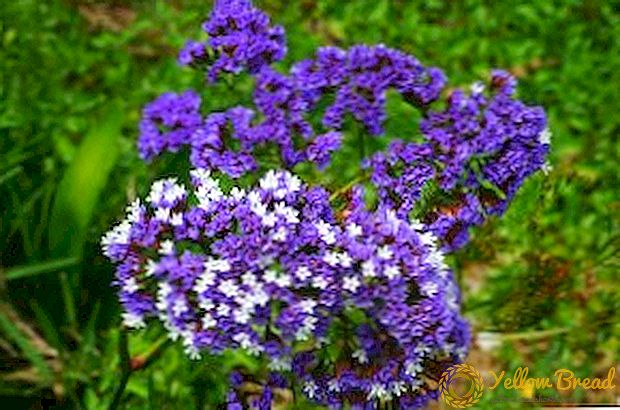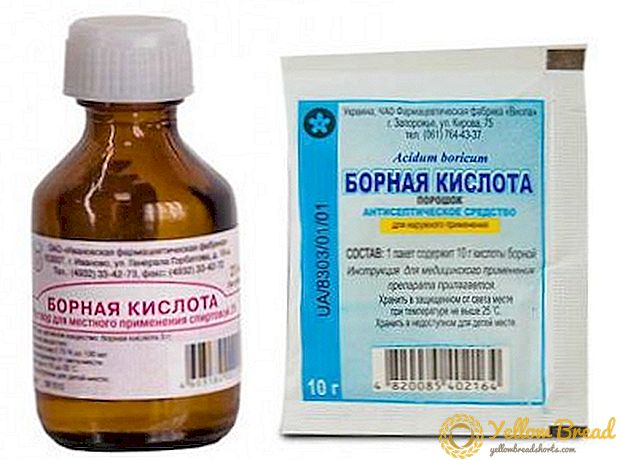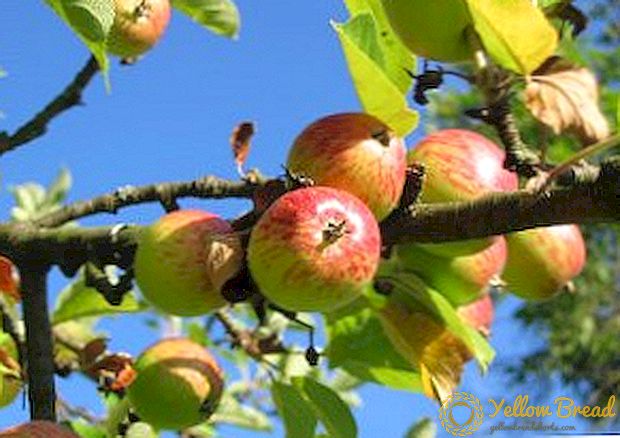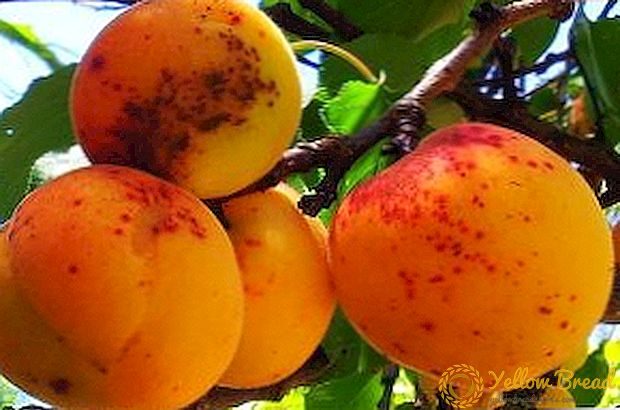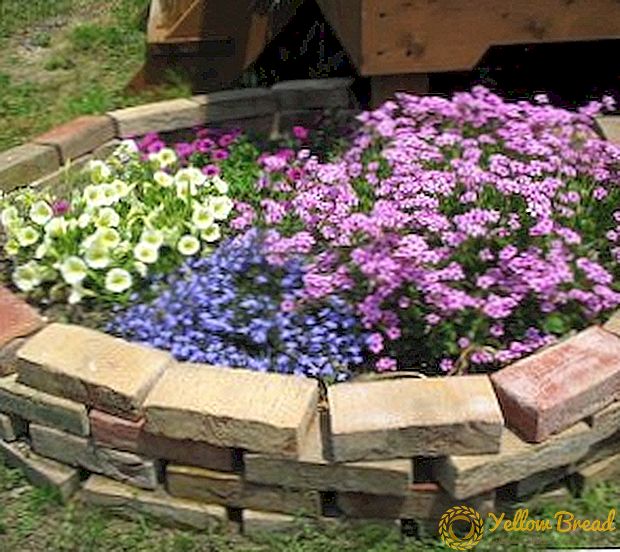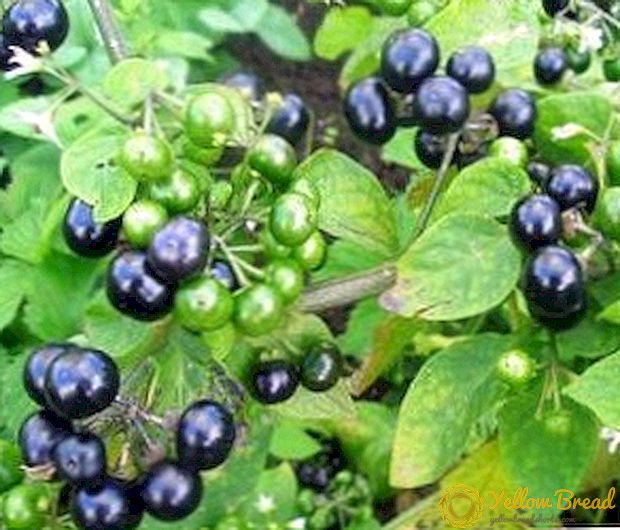 Rowan red (ordinary) is a tree with a pyramidal crown of the correct form. The trunk and branches of mountain ash are covered with smooth gray bark. The height of this plant can reach 15-16 meters.
Rowan red (ordinary) is a tree with a pyramidal crown of the correct form. The trunk and branches of mountain ash are covered with smooth gray bark. The height of this plant can reach 15-16 meters.
- Prevention, means and methods of combating diseases and pests of mountain ash (red)
- Mountain ash diseases: prevention and treatment in case of infection
- Anthracnose
- White spot or septoria
- Brown spot
- Gray spot
- Viral ring mosaic
- Mealy dew
- Monoliosis, or fruit rot
- Scab
- Rust
- Tubercular necrosis
- Cytospor necrosis (cytosporosis)
- Black (biscognioxia) necrosis
- Prevention and methods of combating rowan pests
- Weevil
- Bark beetle
- Moths
- Rowan gall mite
- Rowan moth
- Rowan and green apple aphid
- Apple fruit sawfly
- Shchitovka
The description of mountain ash is worth starting with the area of its growth. It covers the European part of the CIS, as well as the territory of the Caucasus, Siberia, the Far East, Amur, mountainous Kazakhstan and Kyrgyzstan. Most often, the mountain ash grows on the banks of reservoirs, in the meadows, along the road, in the undergrowth of mixed or coniferous forest.Artificial planting places - a variety of gardens, squares and parks.
Prevention, means and methods of combating diseases and pests of mountain ash (red)
Both the seed and the adult rowan tree are susceptible to various infectious diseases, most of which are of fungal origin. Let's see what exactly is the greatest threat to the plant. 
Mountain ash diseases: prevention and treatment in case of infection
Usually, the first signs of damage by pests or diseases manifest themselves in May or June or in the second half of summer. This factor directly depends on the biological characteristics of the causative agent of mountain ash. The mass distribution of diseases is expressed in a strong defeat of the leaves, as well as in their premature drying and falling off. In the aggregate, all this leads to a significant reduction in the ornamental value of the plant and the accumulation of a large number of various infections. One of the main factors contributing to the active development of diseases is the high level of humidity in the spring-summer period.
Anthracnose
Fungi of the genera Kabatiella, Colletotrichum, Gloeosporium are the causative agents of such diseases as anthracnose. In this disease, rowan leaves are covered with brownish-black spots, which are first distinguished by the presence of a darker border around the edges, and then begin to gradually merge. Also on the branches and stalks appear dented stains that prevent the movement of nutrients through the plant.  Anthracnose in its advanced form leads to the development of diseases of the leaves, stems, shoots and fruits - they completely turn brown and then completely dry out. When the weather is dry, the affected areas of the plant crack, and when wet, they rot and nadlamyvayutsya. Anthracnose also leads to the death of the entire aerial part of the plant. The main danger of this disease is that it is easily transmitted through infected plant debris, seeds and soil.
Anthracnose in its advanced form leads to the development of diseases of the leaves, stems, shoots and fruits - they completely turn brown and then completely dry out. When the weather is dry, the affected areas of the plant crack, and when wet, they rot and nadlamyvayutsya. Anthracnose also leads to the death of the entire aerial part of the plant. The main danger of this disease is that it is easily transmitted through infected plant debris, seeds and soil.
At the initial stages of the disease, it is necessary to remove all the affected parts of the plant, and then with an interval of 1.5-3 weeks, two or three times to process it with fungicides. For these purposes, perfect: "Oxy", "Abiga-Peak" or copper sulfate.
White spot or septoria
If over time the mountain ash looks noticeably worse, and the leaf spot becomes more and more, you can be sure that this is a consequence of septoria (also known as white spot).
 The appearance of this disease is caused by a large number of species of fungi of the genus Septoria, which affect the leaves, stems and fruit membranes of mountain ash. Septoria is manifested in the form of a cluster of spots on the leaves, which most often have a clear black border and light blotches in the middle. Gradually, the affected areas die off, and in their place the fungus spores begin to multiply actively. The disease causes a weakening of the plant, and it becomes vulnerable to many other infections and pests.
The appearance of this disease is caused by a large number of species of fungi of the genus Septoria, which affect the leaves, stems and fruit membranes of mountain ash. Septoria is manifested in the form of a cluster of spots on the leaves, which most often have a clear black border and light blotches in the middle. Gradually, the affected areas die off, and in their place the fungus spores begin to multiply actively. The disease causes a weakening of the plant, and it becomes vulnerable to many other infections and pests.
For the treatment of this disease, all the affected leaves must be removed and burned. It is also recommended to use fungicides, for example: "Profit Gold", "Ordan", "High". They are used according to the instructions: before blooming buds, immediately after blooming or after 3 weeks.
Brown spot
Fungi of the genus Phyllosticta sorbi are the causative agent of a disease such as brown spot. Approximately in the second half of summer, the upper side of the leaves of the affected plant is covered with reddish-brown spots with a pronounced red-violet border. Often they have an irregular shape, and with time in the center pycnids of the pathogen appear in the form of crowded small black dots. As the disease progresses, the spots merge and completely cover most of the leaves. The danger of brown spot lies in the fact that it is capable of hitting different types of rowan.  To treat this disease, you must use antifungal agents. These are the so-called fungicides, which contain copper in their composition. Among them are the following drugs: "Ridomil", "Ridomil Gold", "Horus".
To treat this disease, you must use antifungal agents. These are the so-called fungicides, which contain copper in their composition. Among them are the following drugs: "Ridomil", "Ridomil Gold", "Horus".
Gray spot
For the appearance of gray spot meets the fungus of the genus Phyllosticta aucupariae. Gray spot is a fungus disease of the mountain ash, which manifests itself in the second half of the summer. Its main symptoms are gray spots on both sides of the leaves. Spots are framed with a wide dark brown border, irregular or rounded shape. On their upper side, small black dots appear, which are pycnidia of the fungus. Often these stains merge and cover most of the surface of the sheet plate.
With a small number of spots, it is possible to spray the following preparations: "Gamar", "Baktofit", "Vitaplan", "Fitosporin-M".
In case of severe lesions, copper-containing compounds are used, such as: "Kuproksat", "Cuprikol", "Skor", "Fundazol".
Viral ring mosaic
Tobaco ringspot virus, also known as viral ring mosaic, infects the plant in spring. Therefore, if your mountain ash dries, and its leaves are deformed, be sure - you had to face this disease. The main symptom is the appearance of greenish-yellow rings of different sizes. Numerous stains can merge, thus forming a characteristic mosaic pattern. The strong development of the disease leads to the deformation of the affected leaves, after which they become sluggish, wrinkled, shrink and soon fall off completely.  If the mountain ash is heavily affected by a ring mosaic virus, the plant will have to be completely destroyed, and a drug such as "Alirin" is perfect for prevention.
If the mountain ash is heavily affected by a ring mosaic virus, the plant will have to be completely destroyed, and a drug such as "Alirin" is perfect for prevention.
Mealy dew
The appearance of powdery mildew is caused by the fungi of the genus Phyllactinia guttata and Podos-phaera clandestina. Around the second half of July, the leaves are covered with white, cobwebby bloom, either on one side or on both sides. The danger of such a raid is that it easily infects young leaf plates, although damaged rowan shoots are a consequence of powdery mildew. Since the end of summer, spherical bodies of fungi, the so-called cleistothecia, form on the surface of the leaves. At first they look like yellow dots, but as they mature they darken and become dark brown or almost black. Cleistothecia overwinter on fallen leaves and partly on the soil. In spring, mature spores spread and infect young leaves of mountain ash.  In the fight against powdery mildew, the most effective are modern fungicidal agents. They have a detrimental effect on the fungus and stop the harmful processes in plant cells. The most effective preparations for powdery mildew are: Acrobat MC, Vitaros, Fundazol, Previcur.
In the fight against powdery mildew, the most effective are modern fungicidal agents. They have a detrimental effect on the fungus and stop the harmful processes in plant cells. The most effective preparations for powdery mildew are: Acrobat MC, Vitaros, Fundazol, Previcur.
Spraying with such compounds should be carried out 1-4 times with an interval of 7-10 days (it depends on the specific drug).
Monoliosis, or fruit rot
Mushrooms of the group Monilia cydonia are the causative agents of diseases such as monoliosis (also known as fruit rot). They cause necrotic diseases of mountain ash, which affect the fruits and leaves, leading to their decay. Fruit rot infection is carried by insects, wind, and raindrops. It hibernates in the stalk, and with the onset of warm (+ 24 ... + 26 ° C) weather, fungal spores are actively transferred from the mountain ash to the rest of the plants.
 To prevent the appearance of monoliosis, try to prevent damage to the fruits and branches of various pests, birds, hail or garden tools. If this does happen, then all damaged fruits should be removed immediately, and in no case leave them in storage.
To prevent the appearance of monoliosis, try to prevent damage to the fruits and branches of various pests, birds, hail or garden tools. If this does happen, then all damaged fruits should be removed immediately, and in no case leave them in storage.
To combat the fruit rot, the drug Fitosporin-M or a simple solution of iodine is perfect (for this, 10 milliliters of iodine is diluted in 10 liters of water).Trees are treated with solutions in several stages, repeating this procedure 3 days after the first treatment.
Scab
Fusicladium orgiculatum fungi are responsible for the appearance of a disease like scab. The symptom of scab is the formation of small, brown spots of a round or irregular shape with radiant edges, which usually appear in the first half of summer. Later on such stains a bloom develops, the spores of which infect young leaves. A large amount of precipitation during the summer period contributes to the active development of scab, but the main sources of infection are the fallen leaves. In the spring, ripe spores become the cause of the initial infection of young leaves.
For the treatment of scab, it is necessary to combine the application of agrotechnical measures with the subsequent chemical treatment of the plant. All affected shoots, fallen fruits and leaves must be cut, harvested and burned, as well as weed out all weeds. Do not forget to monitor the purity of the tree pristvolnogo circle.
Spraying mountain ash with the drug "DNOC" (diluted in a ratio of 100 grams to 10liters of water) or a solution of the emulsion "Nitrafen" (200 grams per 10 liters of water) will help get rid of such an unpleasant disease as scab.
Rust
The fungus Gymnos-porangium cornutum causes the appearance of rust, also often affecting mountain ash. The disease develops in the presence of two different host plants, which are usually rowan and juniper. In the first half of summer spots appear on mountain ash, and on the upper side of the leaves they are round, with a diameter of 2-5 millimeters. The color of such stains is orange-yellow with dark brown patches. Whitish spots appear on the underside of the leaves, with brown conical outgrowths 1-2 millimeters long. Affected leaves spread the spores of fungi over a distance of up to 250 meters, thus infecting other plants.  Measures to control diseases of mountain ash, such as rust, include the use of preparations containing sulfur in their composition (for example, colloidal sulfur), as well as fungicides (Strobi, Abiga-Peak, Poliram, Cumulus).
Measures to control diseases of mountain ash, such as rust, include the use of preparations containing sulfur in their composition (for example, colloidal sulfur), as well as fungicides (Strobi, Abiga-Peak, Poliram, Cumulus).
Tubercular necrosis
Tubercular necrosis (also called necrosis) is caused by the fungi of the genus Tubercularia vulgaris. One of the specific signs of necrosis is the sporulation of the fungus at different stages of its development.At the very beginning of the cracks of the cortex begin to act numerous stroma. They look like small, smooth pink pads. At the initial stages, it is quite difficult to recognize the appearance of necrosis, since the cortex does not change its color. Therefore, most often, the presence of the disease is noticed when the bark of the mountain ash cracks. Nectarine necrosis is able to infect many deciduous species of plants, which then serve as a source of infection for the mountain ash.  The only effective way to combat necrosis is pruning dead plant parts. As preventive measures can be sprayed branches Bordeaux liquid, which is known for its antiviral and protective properties. You can buy it in almost any specialty store.
The only effective way to combat necrosis is pruning dead plant parts. As preventive measures can be sprayed branches Bordeaux liquid, which is known for its antiviral and protective properties. You can buy it in almost any specialty store.
Cytospor necrosis (cytosporosis)
Mushrooms of the genus Cytospora are the main causative agents of cytosporosis. The first symptoms of this disease are expressed in the appearance on the branches of necrosis of an oval shape, covered with yellowish bark. The affected areas can grow quite quickly, merging and completely ringing the thin trunks and branches of the tree.Numerous small tubercles of conical shape are formed in the thickness of the bark, which with their peaks protrude from the "skin" crevices of the tree. In the spring period or at the beginning of summer, spores emerge from these formations in the form of a mucous mass, which solidify with dark flagella and drops.  Rowan affected by cytosporosis does not respond to treatment, the only way out is to cut down and burn the tree in order to prevent the infection of other plants.
Rowan affected by cytosporosis does not respond to treatment, the only way out is to cut down and burn the tree in order to prevent the infection of other plants.
As a prevention of the appearance of cytospor necrosis, the tree can be treated with a 3% solution of Bordeaux mixture.
Black (biscognioxia) necrosis
Fungus varieties Biscogniauxia repanda is the main culprit in the defeat of mountain ash with black (biscognioxia) necrosis. The bark of a diseased tree acquires a yellowish tint, and then becomes covered with cracks. After some time, the cracks become more and more widening, which leads to lagging of the cortex. At the same time, in places of exfoliation, the edges of cracked bark are wrapped up, and the affected branches become untidy. At the final stage of the disease, the affected parts of the bark fall off, thus exposing the darkened wood.Spores of the fungus are spread by insects and rainwater, thereby affecting other plants in your area.
Unfortunately, the mountain ash tree affected by black necrosis cannot be cured, it must be cut and burned.
For the prevention of the appearance of black necrosis  need to provide:
need to provide:
- systematic control over the possible appearance of the disease during the growing season of the plant;
- careful selection for planting healthy and sturdy planting material;
- timely cutting of affected areas of the plant and removal of drying out plants with their subsequent destruction.
Prevention and methods of combating rowan pests
About 60 species of various insects and herbivorous mites belong to the pests of red rowan. Pests mainly damage the vegetative organs of the plant: seeds, shoots, buds, fruits, flowers and leaves. It should be noted that most of the mountain ash pests are polyphages, that is, they can feed and develop on other species of woody plants, especially those belonging to the family of rosaceous. Pest control of mountain ash includes a whole range of measures, which largely depend on the specific type of insect.
Weevil
 Weevil is a small brown beetle that winters in fallen leaves and bark crevices. When the temperature rises to + 10 ° C, the beetle settles on a mountain ash tree. This pest feeds on the kidneys, gradually eating away from them the core, and then lays eggs in the bud. The hatching larva begins to nibble at the bud, which leads to the gluing and drying of the petals. After that, the young beetle moves to the leaves, gnawing holes in them.
Weevil is a small brown beetle that winters in fallen leaves and bark crevices. When the temperature rises to + 10 ° C, the beetle settles on a mountain ash tree. This pest feeds on the kidneys, gradually eating away from them the core, and then lays eggs in the bud. The hatching larva begins to nibble at the bud, which leads to the gluing and drying of the petals. After that, the young beetle moves to the leaves, gnawing holes in them.
To combat the weevil you need:
- during the period of swelling of the kidneys, shake the beetles from the branches onto the previously spread tarpaulin, and then destroy them in a bucket of salt water;
- use insecticides in the period of the appearance of buds (the best of them is the drug "Karbofos", the instructions for use of which are in the package with the drug).
Bark beetle
 The bark beetle is a small dark-colored bug that gnaws long strokes in the bark, making its way as close as possible to the succulent wood. All vital activity of the bark beetle takes place in the bark of the plant.
The bark beetle is a small dark-colored bug that gnaws long strokes in the bark, making its way as close as possible to the succulent wood. All vital activity of the bark beetle takes place in the bark of the plant.
For mountain ash and the fight against insects, bark beetles useful:
- use such means as: "Aktara", "Lepidotsid", "Confidor";
- spray the mountain ash immediately after flowering and repeat the procedure after 2 weeks (all the tree should be processed: leaves, branches and trunk).
Moths
 Moth, wingspan of an adult insect which is 2.5 centimeters. The moth caterpillar grows up to 2 centimeters in length. Most often, it appears before flowering and nibbles leaves, flowers and buds. Upon completion of flowering mountain ash goes underground to a depth of 10 centimeters, where it begins to pupate. In October, butterflies appear and lay eggs under the plant bark for the winter.
Moth, wingspan of an adult insect which is 2.5 centimeters. The moth caterpillar grows up to 2 centimeters in length. Most often, it appears before flowering and nibbles leaves, flowers and buds. Upon completion of flowering mountain ash goes underground to a depth of 10 centimeters, where it begins to pupate. In October, butterflies appear and lay eggs under the plant bark for the winter.
To combat this pest is necessary:
- process the mountain ash before flowering (it is best to use Karbofos, Cyanox or Chlorophos);
- before blooming buds, to protect against eggs, you can spray the tree "Nitrafen".
Rowan gall mite
 For the winter, hiding in fallen leaves and feeds on their juice. During the summer, is able to give 4 new generations of pests. At about the end of May galls form on both sides of the leaf, which clog the channels for the delivery of nutrients.
For the winter, hiding in fallen leaves and feeds on their juice. During the summer, is able to give 4 new generations of pests. At about the end of May galls form on both sides of the leaf, which clog the channels for the delivery of nutrients.
Among the main drugs for mountain ash pests, including gall mites, is colloidal sulfur (100 grams of the substance is diluted in ten liters of water and the stem and branches of mountain ash are treated with the resulting solution). Also, do not forget to clean the fallen leaves more often, to prevent the appearance of the mountain ash mite.
Rowan moth
Pretty small butterfly, wingspan which is 1.5 centimeters. First of all, it affects the berries of mountain ash. The moth caterpillar is distinguished by a yellow body with a dark head. During the initial stage of fruit-making, the mole lays an average of 50 eggs. The newly formed larvae burrow into the young berries and make twisting passages in them. In the fall, insects are buried in the ground to a depth of ten centimeters, where they pupate and hibernate in the upper layers of the soil under a layer of fallen leaves.
 To combat moths, at the end of June, it is necessary to thoroughly treat the mountain ash with chlorophos (20 grams are diluted in 10 liters of water). As a method of prevention, digging around the circle of the trunk, as well as collecting and burning all the fallen berries and leaves will do.
To combat moths, at the end of June, it is necessary to thoroughly treat the mountain ash with chlorophos (20 grams are diluted in 10 liters of water). As a method of prevention, digging around the circle of the trunk, as well as collecting and burning all the fallen berries and leaves will do.
Rowan and green apple aphid
Insects cause damage to the plant, sucking the juice from the leaves and petioles, as well as from the buds and young shoots, as a result of which the indicated parts of the plant are twisted and the shoots are strongly curved.
Rowan aphid lays shiny black eggs directly on annual shoots, and in the egg stage, the pest tolerates the entire winter period. It is possible to fight with rowan and green aphids by spraying the plant with insecticides, such as: “Decis” and “Actellic”.
Apple fruit sawfly
 If you notice a small brown insect with transparent wings, rest assured - this apple fruit sawfly. The larva of this pest reaches 1.5 centimeters in length, the body is shiny, yellow in color, strongly wrinkled. The female sawfly lays its eggs directly in flowers with future ovaries, and the larvae that appear with their vital activity cause great harm to mountain ash.
If you notice a small brown insect with transparent wings, rest assured - this apple fruit sawfly. The larva of this pest reaches 1.5 centimeters in length, the body is shiny, yellow in color, strongly wrinkled. The female sawfly lays its eggs directly in flowers with future ovaries, and the larvae that appear with their vital activity cause great harm to mountain ash.
To fight an insect, take 10 grams of white mustard powder, fill it with a liter of water, and draw the resulting solution for 24 hours. After that, dilute it with water in a ratio of 1: 5 and process the whole tree with the composition obtained.
Shchitovka
 A shield is a small insect whose body is covered with a kind of wax shield. The main danger is the larvae that feed on plant sap. To fight with the shield you need to spray the trunk and branches before bud break. Strictly according to the instructions used insecticide "30 Plus". Also, do not forget to puncture the crown of mountain ash in a timely manner, trim and destroy badly affected branches.
A shield is a small insect whose body is covered with a kind of wax shield. The main danger is the larvae that feed on plant sap. To fight with the shield you need to spray the trunk and branches before bud break. Strictly according to the instructions used insecticide "30 Plus". Also, do not forget to puncture the crown of mountain ash in a timely manner, trim and destroy badly affected branches.
Having shown his care and provided the plant with proper care, the mountain ash will certainly please you with its nutritional, melliferous, medical and decorative properties.

